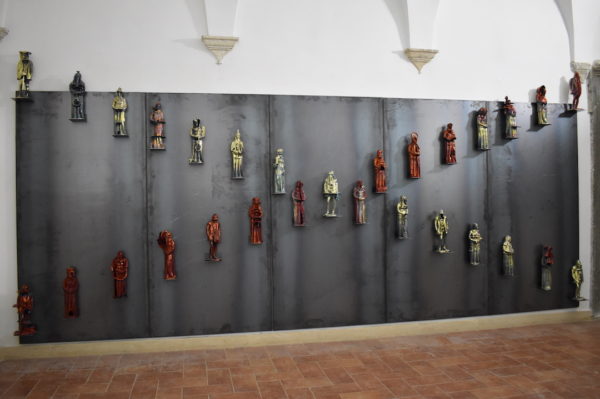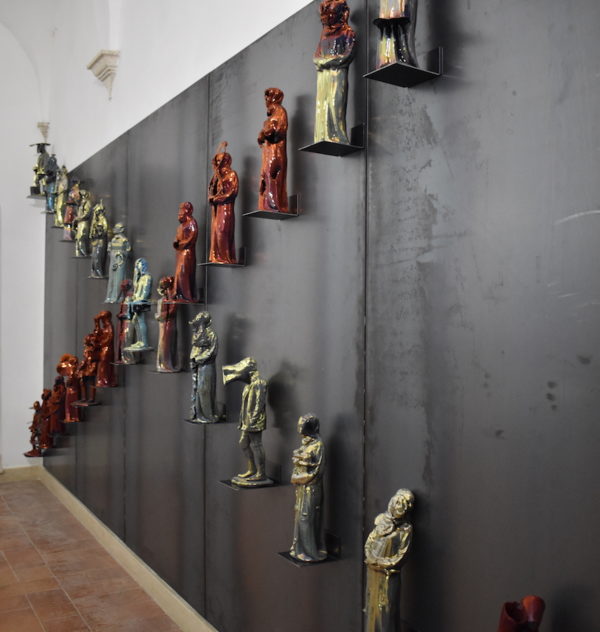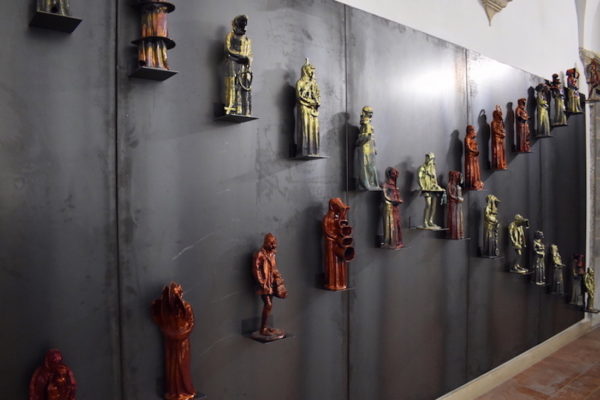Partecipazione collettiva : Paolo Porelli & Maurizio Tittarelli Rubboli
Immagini
Dettagli
Altezza (cm): 230
Larghezza (cm): 505
Profondità (cm): 20
Peso (kg): 120
Materia e tecnica: Terra rosso da colaggio / red earthenware slip
Tecnica: (English below) Da due immagini scannerizzate in 3D, due modelli sono stati stampati con una stampante 3D in argilla a cui sono stati fatti i calchi in gesso. Sono stati poi foggiati dei multipli con terra rossa da colaggio che sono stati sottoposti a delle modifiche con vari interventi espressivi di diverse tecniche ceramiche. Tra le tecniche usate sui multipli a colaggio allo stato plastico per sovvertire la serialità ricordiamo: l\'incisione, l\'intaglio, il traforato, l\'impressione, lo stampo, paper clay, modellatazione plastica, calchi d\'object trouvé, materiale organico. Le sculture sono state poi biscottate alla temperatura tra 1060 e 1100 gradi. La seconda cottura è stata effettuata con la tecnica del lustro in vernice, rosso rubino e dorato cotto a bassa temperatura con affumicatura. L\'installazione e\' composta di cinque pannelli in ferro da 1 x 2 metri ognuno a cui sono attaccate mensole autoreggenti con calamite su cui appoggiano le sculture. Technical description: From two scanned 3-D images, two models were printed using a clay 3-D printer that were cast in plaster. Multiples slip-cast in red earthenware were then subjected to modification using various expressive interventions of diverse ceramic techniques. Among the techniques used on the slip-cast multiples to subvert seriality: incision, intaglio, impression, casting, modelling, casts of found objects, immersion in slip of organic and synthetic materials. The sculptures were then bisque fired to a temperature of 1060-1100 Celsius. The second firing was low-fire in reduction using the in-glaze luster technique to produce ruby red and gold. The installation is composed of five iron panels measuring 1 x 2 meters each to which were attached self-supporting shelves with magnets on which the sculptures are placed.
Anno di completamento: 2019
Materiali e tecniche
atmosfera riducente
traforo (decorazione a)
riflesso metallico
lustro
incisione
impressione
stampatura
modellazione plastica
colaggio
object trouvé
materiale organico
erba
terracotta
ossidi
Edizione
“RefleX: figure X riflettere” (English below) “RefleX” è un’installazione di 29 figure in terracotta smaltata a lustro in vernice che si sviluppa su una parete rettangolare lungo le sue diagonali volendo sottolineare ortograficamente la X finale della parola reflex. Sopratutto la X vuole essere il simbolo dell’infinito prospettico del cambiamento dimensionale che la percezione compie e di cui le figure vogliono essere testimone. L’ “X factor” si identifica anche con l’indefinito, l’incognita e l’infigurabile che il processo vitale esercita continuamente e che le 29 figure con le loro superfici riflettenti, vogliono con il gioco di parole del titolo, portarci a riflettere. La foggiatura è stata curata dallo scultore Paolo Porelli durante il suo soggiorno in residenza all’EKWC (European Ceramic Work Center) in Olanda partendo da due modelli stampati in 3D a cui sono stati fatti i calchi in gesso per creare dei multipli. Successivamente ogni figura fatta a colaggio è stata modificata con vari interventi per dare ognuna la sua individualità. Dopo la cottura a biscotto le opere sono passate nello studio del maestro ceramista Maurizio Tittarelli Rubboli l’attuale discendente della storica manifattura Rubboli fondata a Gualdo Tadino nel 1873 che le ha smaltate con la tecnica del lustro in vernice con affumicazione. “RefleX: figures for reflection” “RefleX” is an installation of 29 terracotta figures glazed with in-glaze lustre that extends along the diagonals of a rectangular wall to emphasise orthographically the final X of the word reflex. Above all, the X seeks to symbolise the infinite perspective of dimensional changes that perception creates and that the figures want to bear witness to. The “X factor” identifies itself with the indefinite, the unknown and that which cannot be represented that the vital process exercises continually and that the 29 figures with their reflective surface urge us to reflect upon as suggested by the word play of the title. The modelling of the sculptures was done by Paolo Porelli during his residency at EKWC (European Ceramic Work Center in the Netherlands). Starting from two models printed in 3-D, a plaster mould was produced to create multiples. Later each figure was slip-cast with red earthenware and modified to grant each its individuality. After the bisque firing, the works were taken to the studio of the ceramic maestro Maurizio Tittarelli Rubboli, the last descendent of the historical Rubboli luster workshop founded in Gualdo Tadino in 1873, who glazed them using the technique of in-glaze lustre in reduction.



